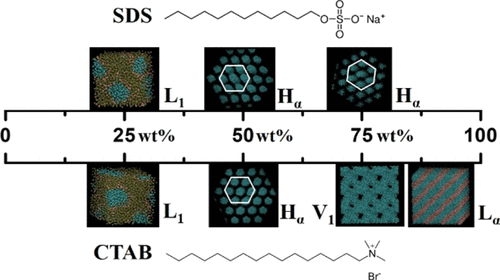当前位置:
X-MOL 学术
›
J. Phys. Chem. B
›
论文详情
Our official English website, www.x-mol.net, welcomes your
feedback! (Note: you will need to create a separate account there.)
Promising Route for the Development of a Computational Framework for Self-Assembly and Phase Behavior Prediction of Ionic Surfactants Using MARTINI.
The Journal of Physical Chemistry B ( IF 2.8 ) Pub Date : 2020-01-10 , DOI: 10.1021/acs.jpcb.9b09915 Stefanos D Anogiannakis 1 , Panagiotis C Petris 1 , Doros N Theodorou 1
The Journal of Physical Chemistry B ( IF 2.8 ) Pub Date : 2020-01-10 , DOI: 10.1021/acs.jpcb.9b09915 Stefanos D Anogiannakis 1 , Panagiotis C Petris 1 , Doros N Theodorou 1
Affiliation

|
Surfactants are amphiphilic molecules with multiple uses and industrial applications as detergents, wetting agents, emulsifiers, and so forth. They can be divided into three main categories: nonionic, ionic, and zwitterionic. The development of a universal computational framework able to predict key properties such as their critical micelle concentration (cmc) and the size of the micelles they form and to ultimately extract phase diagrams for their aqueous solutions, possibly in the presence of salts and oils, using their chemical constitution as input, would provide valuable information for the design and the production of these materials. In this work, we focus on ionic surfactants and investigate a possible route toward the development of such a framework based on coarse-grained simulations using the MARTINI forcefield in two versions: its implicit solvent version, called Dry MARTINI, and its explicit solvent version, called Wet MARTINI. The surfactants considered in our efforts are the anionic sodium dodecyl sulfate (SDS) and the three cationic cetyl, dodecyl, and octyl trimethyl ammonium bromide (CTAB, DTAB, and OTAB, respectively). First, we choose their mapping onto coarse-grained MARTINI beads. Next, we estimate their cmc's, their peak aggregation numbers, Nagg, and in the case of SDS, its small angle neutron scattering pattern at low concentrations, applying the Dry MARTINI forcefield. With a single modification to the Lennard-Jones energy parameter between hydrophobic beads and invoking Ewald summation with a physically meaningful dielectric constant for electrostatic interactions, our estimates are in very good agreement with experimental results. Furthermore, we predict the phase behavior of SDS/water and CTAB/water binary solutions using Wet MARTINI and find semiquantitative agreement with experimental phase diagrams. We conclude that the MARTINI forcefield, with careful treatment of electrostatic interactions and appropriate modification of parameters for some key functional groups, can be a powerful ally in the quest for a universal computational framework for the design of new surfactants with improved properties.
中文翻译:

使用MARTINI开发离子表面活性剂的自组装和相行为预测计算框架的有前途的途径。
表面活性剂是具有多种用途和工业应用的两亲性分子,作为去污剂,湿润剂,乳化剂等。它们可以分为三个主要类别:非离子,离子和两性离子。通用计算框架的开发能够预测关键特性,例如其临界胶束浓度(cmc)和它们形成的胶束大小,并最终提取水溶液的相图(可能在存在盐和油的情况下),方法是它们的化学成分作为输入,将为这些材料的设计和生产提供有价值的信息。在这项工作中,我们将重点放在离子表面活性剂上,并根据使用两个版本的MARTINI力场进行的粗粒度模拟,研究开发这种框架的可能途径:它的隐式溶剂版本称为Dry MARTINI,其显式溶剂版本称为Wet MARTINI。我们努力中考虑的表面活性剂是阴离子十二烷基硫酸钠(SDS)和三种阳离子十六烷基,十二烷基和辛基三甲基溴化铵(分别为CTAB,DTAB和OTAB)。首先,我们选择将它们映射到粗粒度的MARTINI珠子上。接下来,我们使用Dry MARTINI力场,估计它们的cmc,峰聚集数Nagg,以及在SDS的情况下估计其在低浓度下的小角度中子散射模式。通过对疏水珠之间的Lennard-Jones能量参数进行单次修改,并使用具有物理意义的介电常数进行静电相互作用的Ewald总和,我们的估计与实验结果非常吻合。此外,我们使用Wet MARTINI预测SDS /水和CTAB /水二元溶液的相行为,并找到与实验相图的半定量一致性。我们得出的结论是,MARTINI力场经过精心处理的静电相互作用和对某些关键官能团的参数的适当修改,可以成为寻求通用计算框架以设计具有改进性能的新型表面活性剂的强大盟友。
更新日期:2020-01-10
中文翻译:

使用MARTINI开发离子表面活性剂的自组装和相行为预测计算框架的有前途的途径。
表面活性剂是具有多种用途和工业应用的两亲性分子,作为去污剂,湿润剂,乳化剂等。它们可以分为三个主要类别:非离子,离子和两性离子。通用计算框架的开发能够预测关键特性,例如其临界胶束浓度(cmc)和它们形成的胶束大小,并最终提取水溶液的相图(可能在存在盐和油的情况下),方法是它们的化学成分作为输入,将为这些材料的设计和生产提供有价值的信息。在这项工作中,我们将重点放在离子表面活性剂上,并根据使用两个版本的MARTINI力场进行的粗粒度模拟,研究开发这种框架的可能途径:它的隐式溶剂版本称为Dry MARTINI,其显式溶剂版本称为Wet MARTINI。我们努力中考虑的表面活性剂是阴离子十二烷基硫酸钠(SDS)和三种阳离子十六烷基,十二烷基和辛基三甲基溴化铵(分别为CTAB,DTAB和OTAB)。首先,我们选择将它们映射到粗粒度的MARTINI珠子上。接下来,我们使用Dry MARTINI力场,估计它们的cmc,峰聚集数Nagg,以及在SDS的情况下估计其在低浓度下的小角度中子散射模式。通过对疏水珠之间的Lennard-Jones能量参数进行单次修改,并使用具有物理意义的介电常数进行静电相互作用的Ewald总和,我们的估计与实验结果非常吻合。此外,我们使用Wet MARTINI预测SDS /水和CTAB /水二元溶液的相行为,并找到与实验相图的半定量一致性。我们得出的结论是,MARTINI力场经过精心处理的静电相互作用和对某些关键官能团的参数的适当修改,可以成为寻求通用计算框架以设计具有改进性能的新型表面活性剂的强大盟友。











































 京公网安备 11010802027423号
京公网安备 11010802027423号